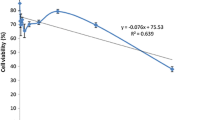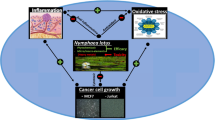Abstract
Calyptranthes tricona is a species (Myrtaceae) native to South Brazil. Plants belonging to this family are folkloric used for analgesia, inflammation, and infectious diseases. However, little is known about the toxic potential of C. tricona. The present study aimed to evaluate the antioxidant activity of C. tricona ethanol and hexane leaf extracts, as well as verify their effect on human lymphocytes and MCF-7 cells. The extracts were subjected to preliminary phytochemical screening, antioxidant activity using DPPH and ORAC methods. Genotoxic and mutagenic effects in cultured human lymphocytes were assessed using the comet assay and the micronucleus assay, respectively. In addition, cell viability by MTT assay and fluorometric analysis of mitochondrial potential and caspases-9 activity were performed in order to verify the possible effects of both extracts on H2O2-induced cell death of MCF-7 cells. Our findings revealed that the phenol content and the antioxidant activity were only present in the ethanol extract. Also, the phytochemical screening presented steroids, triterpenoids, condensed tannins, and flavones as the main compounds. However, both extracts were capable of inducing concentration-dependent DNA damage in human lymphocytes. When treating MCF-7 cells with the extracts, both of them inhibited MCF-7 cell death in response to oxidative stress through a decrease of mitochondrial depolarization and caspases-9 activity. Thus, our results need to be considered in future in vitro and in vivo studies of C. tricona effects. In the meanwhile, we recommend caution in the acute/chronic use of this homemade preparation for medicinal purpose.





Similar content being viewed by others
References
Mendis S, Fukino K, Cameron A, Laing R, Filipe A Jr, Khatib O, Leowski J, Ewen M (2007) The availability and affordability of selected essential medicines for chronic diseases in six low- and middle-income countries. Bull World Health Organ 85:279–288
Cordell GA, Colvard MD (2012) Natural products and traditional medicine: turning on a paradigm. J Nat Prod 75:514–525. doi:10.1021/np200803m
Dastmalchi K, Flores G, Wu SB, Ma C, Dabo AJ, Whalen K, Reynertson KA, Foronjy RF, JM DA, Kennelly EJ (2012) Edible Myrciaria vexator fruits: bioactive phenolics for potential COPD therapy. Bioorg Med Chem 20:4549–4555. doi:10.1016/j.bmc.2012.05.013
Takao LK, Imatomi M, Gualtieri SC (2015) Antioxidant activity and phenolic content of leaf infusions of Myrtaceae species from Cerrado (Brazilian Savanna). Braz J Biol 75:948–952. doi:10.1590/1519-6984.03314
de Figueiroa EO, da Silva LCN, de Melo CM, Neves JK, da Silva NH, Pereira VR, Correia MT (2013) Evaluation of antioxidant, immunomodulatory, and cytotoxic action of fractions from Eugenia uniflora L. and Eugenia malaccensis L.: correlation with polyphenol and flavanoid content. Sci World J. doi:10.1155/2013/125027
Stefanello ME, Pascoal AC, Salvador MJ (2011) Essential oils from neotropical Myrtaceae: chemical diversity and biological properties. Chem Biodivers 8:73–94. doi:10.1002/cbdv.201000098
Borges LL, Conceicao EC, Silveira D (2014) Active compounds and medicinal properties of Myrciaria genus. Food Chem 153:224–233. doi:10.1016/j.foodchem.2013.12.064
Thornhill AH, Ho SY, Kulheim C, Crisp MD (2015) Interpreting the modern distribution of Myrtaceae using a dated molecular phylogeny. Mol Phylogenet Evol 93:29–43. doi:10.1016/j.ympev.2015.07.007
Sagrillo MR, Garcia LF, de Souza Filho OC, Duarte MM, Ribeiro EE, Cadona FC, da Cruz IB (2015) Tucuma fruit extracts (Astrocaryum aculeatum Meyer) decrease cytotoxic effects of hydrogen peroxide on human lymphocytes. Food Chem 173:741–748. doi:10.1016/j.foodchem.2014.10.067
Bonoli M, Verardo V, Marconi E, Caboni MF (2004) Antioxidant phenols in barley (Hordeum vulgare L.) flour: comparative spectrophotometric study among extraction methods of free and bound phenolic compounds. J Agric Food Chem 52:5195–5200. doi:10.1021/jf040075c
da Silva Brum E, da Rosa Moreira L, da Silva AR, Boligon AA, Carvalho FB, Athayde ML, Brandao R, Oliveira SM (2016) Tabernaemontana catharinensis ethyl acetate fraction presents antinociceptive activity without causing toxicological effects in mice. J Ethnopharmacol. doi:10.1016/j.jep.2016.06.036
Mensor LL, Menezes FS, Leitao GG, Reis AS, dos Santos TC, Coube CS, Leitao SG (2001) Screening of Brazilian plant extracts for antioxidant activity by the use of DPPH free radical method. Phytother Res 15:127–130
Dávalos A, Gómez-Cordovés C, Bartolomé B (2004) Extending applicability of the oxygen radical absorbance capacity (ORAC-fluorescein) assay. J Agric Food Chem 52:48–54
Turkez H, Aydin E, Geyikoglu F, Cetin D (2015) Genotoxic and oxidative damage potentials in human lymphocytes after exposure to terpinolene in vitro. Cytotechnology 67:409–418. doi:10.1007/s10616-014-9698-z
Singh NP, McCoy MT, Tice RR, Schneider EL (1988) A simple technique for quantitation of low levels of DNA damage in individual cells. Exp Cell Res 175:184–191
Fenech M (2000) The in vitro micronucleus technique. Mutat Res 455:81–95
Mosmann T (1983) Rapid colorimetric assay for cellular growth and survival: application to proliferation and cytotoxicity assays. J Immunol Methods 65:55–63
RCoreTeam (2014) R: a language and environment for statistical computing. R Foundation for Statistical Computing, Vienna
Tian T, Olson S, Whitacre JM, Harding A (2011) The origins of cancer robustness and evolvability. Integr Biol (Camb) 3:17–30. doi:10.1039/c0ib00046a
Wink M (2015) Modes of action of herbal medicines and plant secondary metabolites. Medicines. doi:10.3390/medicines2030251
Dinic J, Podolski-Renic A, Stankovic T, Bankovic J, Pesic M (2015) New approaches with natural product drugs for overcoming multidrug resistance in cancer. Curr Pharm Des 21:5589–5604
Menut C, Bessiere JM, Ntalani H, Verin P, Henriques AT, Limberger R (2000) Two chromene derivatives from Calyptranthes tricona. Phytochemistry 53:975–979
Fu X-B, Wang X-F, Chen J-N, Wu D-W, Li T, Shen X-C, Qin J-K (2015) Synthesis, fluorescence properties, and antiproliferative potential of several 3-Oxo-3H-benzo[f]chromene-2-carboxylic acid derivatives. Molecules 20:18565
Salem M, Marzouk M, El-Kazak A (2016) Synthesis and characterization of some new coumarins with in vitro antitumor and antioxidant activity and high protective effects against DNA damage. Molecules 21:249
Salvador MJ, de Lourenco CC, Andreazza NL, Pascoal AC, Stefanello ME (2011) Antioxidant capacity and phenolic content of four Myrtaceae plants of the south of Brazil. Nat Prod Commun 6:977–982
Amensour M, Sendra E, Abrini J, Bouhdid S, Perez-Alvarez JA, Fernandez-Lopez J (2009) Total phenolic content and antioxidant activity of myrtle (Myrtus communis) extracts. Nat Prod Commun 4:819–824
Tawaha K, Alali FQ, Gharaibeh M, Mohammad M, El-Elimat T (2007) Antioxidant activity and total phenolic content of selected Jordanian plant species. Food Chem 104:1372–1378. doi:10.1016/j.foodchem.2007.01.064
Saeed N, Khan MR, Shabbir M (2012) Antioxidant activity, total phenolic and total flavonoid contents of whole plant extracts Torilis leptophylla L. BMC Complement Altern Med 12:221. doi:10.1186/1472-6882-12-221
Wang WH, Tyan YC, Chen ZS, Lin CG, Yang MH, Yuan SS, Tsai WC (2014) Evaluation of the antioxidant activity and antiproliferative effect of the jaboticaba (Myrciaria cauliflora) seed extracts in oral carcinoma cells. Biomed Res Int 2014:185946. doi:10.1155/2014/185946
Araldi RP, de Melo TC, Mendes TB, de Sa Junior PL, Nozima BH, Ito ET, de Carvalho RF, de Souza EB, de Cassia Stocco R (2015) Using the comet and micronucleus assays for genotoxicity studies: a review. Biomed Pharmacother 72:74–82. doi:10.1016/j.biopha.2015.04.004
Avishai N, Rabinowitz C, Rinkevich B (2003) Use of the comet assay for studying environmental genotoxicity: comparisons between visual and image analyses. Environ Mol Mutagen 42:155–165. doi:10.1002/em.10189
de Souza Filho OC, Sagrillo MR, Garcia LF, Machado AK, Cadona F, Ribeiro EE, Duarte MM, Morel AF, da Cruz IB (2013) The in vitro genotoxic effect of Tucuma (Astrocaryum aculeatum), an Amazonian fruit rich in carotenoids. J Med Food 16:1013–1021. doi:10.1089/jmf.2012.0287
Nicholls DG (2004) Mitochondrial membrane potential and aging. Aging Cell 3:35–40
McIlwain DR, Berger T, Mak TW (2013) Caspase functions in cell death and disease. Cold Spring Harb Perspect Biol 5:a008656. doi:10.1101/cshperspect.a008656
Tor YS, Yazan LS, Foo JB, Wibowo A, Ismail N, Cheah YK, Abdullah R, Ismail M, Ismail IS, Yeap SK (2015) Induction of apoptosis in MCF-7 cells via oxidative stress generation, mitochondria-dependent and caspase-independent pathway by ethyl acetate extract of Dillenia suffruticosa and its chemical profile. PLoS One. doi:10.1371/journal.pone.0127441
Acknowledgments
We thank Ms. Andréa Horst from the Physiology Department of Universidade Federal do Rio Grande do Sul (UFRGS) and Dr. Adriane Pozzobon from Centro Universitário UNIVATES for technical assistance. This work was supported by Centro Universitário UNIVATES and the National Counsel of Technological and Scientific Development (CNPq). DMK, DF, and SB are the recipients of Master grants and a postdoctoral grant from Coordenação de Aperfeiçoamento de Pessoal de Nível Superior (Capes), respectively.
Author information
Authors and Affiliations
Corresponding author
Ethics declarations
Conflict of interest
The authors declare that they have no conflict of interest.
Rights and permissions
About this article
Cite this article
Kich, D.M., Bitencourt, S., Caye, B. et al. Lymphocyte genotoxicity and protective effect of Calyptranthes tricona (Myrtaceae) against H2O2-induced cell death in MCF-7 cells. Mol Cell Biochem 424, 35–43 (2017). https://doi.org/10.1007/s11010-016-2840-9
Received:
Accepted:
Published:
Issue Date:
DOI: https://doi.org/10.1007/s11010-016-2840-9




